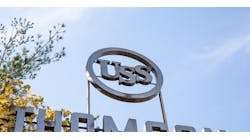"The risk is becoming significantly smaller,” Toyota Motor Corp. CFO Kenta Kon (pictured above) said in early November on the topic of the global semiconductor shortage. But make no mistake: The risk is still very much there, as Kon himself was quick to point out to analysts and reporters after the Toyota team slightly lowered its 2021 sales forecast: “We’re not in a [place] to say the risk is zero. I don’t think the situation allows us to say that yet.”
Manufacturing market watchers looking to take away one thing from the boatload of earnings reports this fall from some of the biggest names in business—headaches bedeviling large parts of the global supply chain are going to be a big story well into 2022 and perhaps even longer. General Electric’s Larry Culp said his team is playing Whac-A-Mole keeping with supply chain snags. While some of his peers voiced optimism that things are getting better, he said he wasn’t yet seeing improvement.
“We may have lines of sight, we may have improvements in one commodity or one line of business,” he said. “But almost without fail, the next day, a commodity, a supplier, a logis- tics provider that we thought was good for the next six weeks or the next six months offers up a revision to that outlook […] It just seems like every day, there’s new news to balance.” There was plenty of other news from this past earnings season. Here are a few other things we took note of during executives’ discussions of their results:
• A byproduct of consumers’ enduring appetite for cars, homes and many other products—and a way to offset some of the enduring pressure on supply chains—is that companies have pricing power that looks like it’ll stick for a bit. General Motors CFO Paul Jacobson said on the heels of that company’s third-quarter report that the auto giant has learned “a lot of lessons in inventory management” during the past year and a half that have informed its pricing strategies. “As we come through this over the longer term, we’ll continue to manage that dynamically through the market,” (emphasis added) Jacobson said in a bit of coded Wall Street language. “But I expect [inventories] to be less than historical levels.”
“We don’t have big projects to build new plants, build capacity,” Goncalves said after reporting a bumper set of numbers. “This mistake has been made for so many times [...] And it’s sad to see the same mistake being made again, but it’s not going to be made by Cleveland-Cliffs.”
Jeff Windau, an industrials analyst at Edward Jones, said the strong end demand underpinning the economy is giving manufacturers the ability to pass on their rising materials and labor costs—for now.
“A lot of quarters have been made by strong pricing,” Windau said. “It will be interesting to see how that changes when the supply chain pressures ease.”
• We were reminded a number of times that execution is still king and still quite prized by investors. Before Elon Musk asked Twitter about selling a chunk of his holdings in Tesla—the papers for which he’d weeks before filed with the Securities and Exchange Commission—the stock had rallied on the back of an earnings report highlighted in part by automotive gross margins of more than 30%, nearly 300 basis points higher than in the third quarter of last year, and a production run rate that hit 1 million for the first time late in the quarter.
Similarly, GM’s Jacobson lauded the “innovative work” being done by plant teams as a factor in why the company’s capital spending will be about $1 billion lower than the previously expected range of $9 billion to $10 billion.
“Everything is progressing on schedule and on target,” Jacobson said of GM’s ambitious plans to electrify its fleet. “The efficiency of the investment […] has gotten better.”
Somewhat on the flipside was Arrival, the fledgling electric vehicle maker ramping up its operations and looking to roll out its buses and vans in coming years. Investors punished the company’s shares after founder Denis Sverdlov and his team withdrew their long-term guidance and said revenues next year will be “modest” while they spend more time refining their manufacturing and logistics processes.
• Building on the execution theme, Ford Motor Co. CEO Jim Farley’s thoughts on his company’s progress caught our ear. Those looking primarily at the company’s longer- term prospects in this era of rapid change likely took heart in Farley saying, “the culture is starting to change” as it increasingly prizes agility, innovation and speed to market.
Farley joined Ford from Toyota in late 2007 and took over as CEO from Jim Hackett in October of last year. Before that, he was COO for a few months and led the company’s new business, technology and strategy group, a role that put him at the forefront of many of the digital- and EV-focused initiatives now at the top of the agenda. Asked by an analyst about a pace of change in the EV market that feels like it’s accelerating, Farley said Ford is beginning to reap the rewards of “tough choices” its leaders made several years ago—including ditching the production of many cars in 2018.
“We have a plan. It’s not advertising or a PR tagline; everyone in the company knows what we have to do,” Farley said. “We are out of time, and we have focus. We need to get an 8% margin as a company because we have to fund a high-growth [EV] and digital business.”
“We have to do our job to break constraints now,” Farley added shortly thereafter. He was referring specifically to Ford’s plan to ramp up EV production but forgive us if we also took it as a call to action for how we all can approach 2022.





